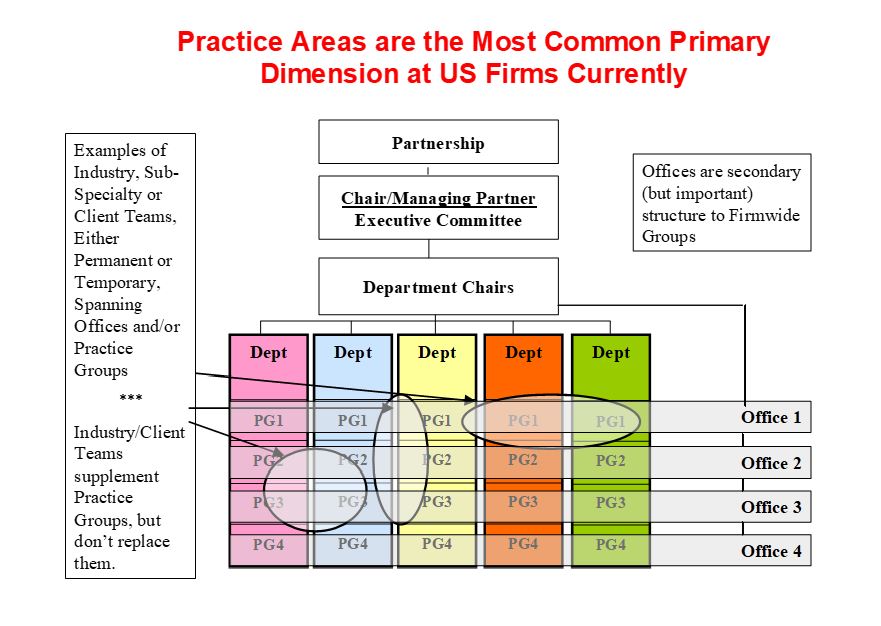We examine which works better for a law firm and its clients — organizing the firm around Practice Groups or around Industry Groups?
Over the past 25 years as we helped law firms set up their practice management structures or trained their leaders, some best practices have changed, and some new ones have emerged.
Too many law firm leaders see industry or client teams simply as a part of their marketing program or a cross-selling strategy, rather than a part of the fundamental structure of how they manage their law firms. As a result, in many firms, these initiatives have failed.
The Role of Industry Teams
Practice management basically means managing the firm through smaller business units (BUs) that are responsible for strategy, profitability, and management of the work process, client relationships, and talent. These BUs can be based on substantive practice areas, offices, industry niches, and clients. For at least the past 15 years or so, many firms have had a matrix structure consisting of all four of these categories, which are dimensions of effective practice management and are important to the success of most firms (see chart below).

The key question in a firm is which dimension will be the primary one through which the people, strategy, and profitability are primarily managed. Any of the four levels can be the primary one — but they cannot all be equal. Lawyers must be willing to be a member of only one primary BU (even though most firms allow them to be a member of several secondary groups). Most lawyers in a firm do not practice primarily in only one industry, so they are unwilling to be pigeonholed in only one industry BU as a primary. Usually, they are more willing to be in one practice-based BU as their primary grouping.
At the same time, managing a law firm along a single dimension (e.g., using only practice groups based on substantive practice areas as BUs) tends to be inadequate and ineffective. Within the strategy of most law firms today, there is a strong focus on core clients and industry specialization. As a result, there is a need for additional secondary BUs (in addition to offices) to manage this focus — these are generally called industry and client teams.
Even in firms that have some industry-based groups within their traditional practice group structure, there are often major areas of industry focus that are too comprehensive to be within a single practice group. For example, in many firms of 300 or more lawyers, there are some industry niches where 50 to 100 of a firm’s lawyers have experience across many substantive practices. Thus, it is important to have organized your firm’s industry BUs to bring together lawyers across a wide spectrum of practices — for purposes other than the day-to-day management of the people or work which is handled in the primary substantive practice-based BU.
The objectives for industry teams vary but typically include:
-
-
- Identifying and enhancing the firm’s market share and visibility within an industry (through organized approaches to thought leadership, business development, and client management);
- Helping to integrate lawyers from various offices and practice groups to prevent “silo” approaches to business development; and
- Differentiating the firm based on the industries it has distinctive expertise in.
-
Best Practices for Successful Industry Teams
Here are some of the best practices from our work with more than half the AmLaw 200 as well as from research for several books written on practice management:
-
-
- Practice management (by any of the four dimensions discussed above) does not work if lawyers do not accept accountability to the primary BU where they contribute a significant amount of their time and are managed by their leaders. Lawyers who work in only one industry are rare in law firms today, although as firms continue to grow, it will become more common. In the future, more professionals will likely be willing to commit to a primary industry group as their “homeroom” and their substantive practice group may become a secondary management dimension for maintenance of specialization, risk management, and related issues only. However, today, that is not an effective way of managing people and profitability, even as industry groups remain critical for thought leadership and business development (what are often called “go to market” BUs).
- Whether industries are a primary or secondary dimension of the firm’s structure, the leaders need to report to a member of firm management and be accountable for their time and energy, for achievement of financial and other performance metrics (which depend on whether it’s a primary or secondary level group), and for building a high-performing team. Just as most firms have trained their practice group leaders (PGLs) in various areas of management and leadership, industry group leaders should be part of those programs and receive high-quality training as well.
- There should be a written job description for industry group leaders, just as the vast majority of firms have detailed job descriptions and expectations for their PGLs.
- Roles and responsibilities for all these leaders should be defined, and the overlap or intersection between PGLs and industry leaders should be clarified as much as possible. In too many firms, this has not been done, and therefore unnecessary tensions arise, or confusion exists between these two roles.
- There should be regular meetings of PGLs and industry leaders to share best practices, obtain training, and generally communicate about their group’s issues and challenges.
-
With these in place, your firm’s practice and industry groups should be successful.







